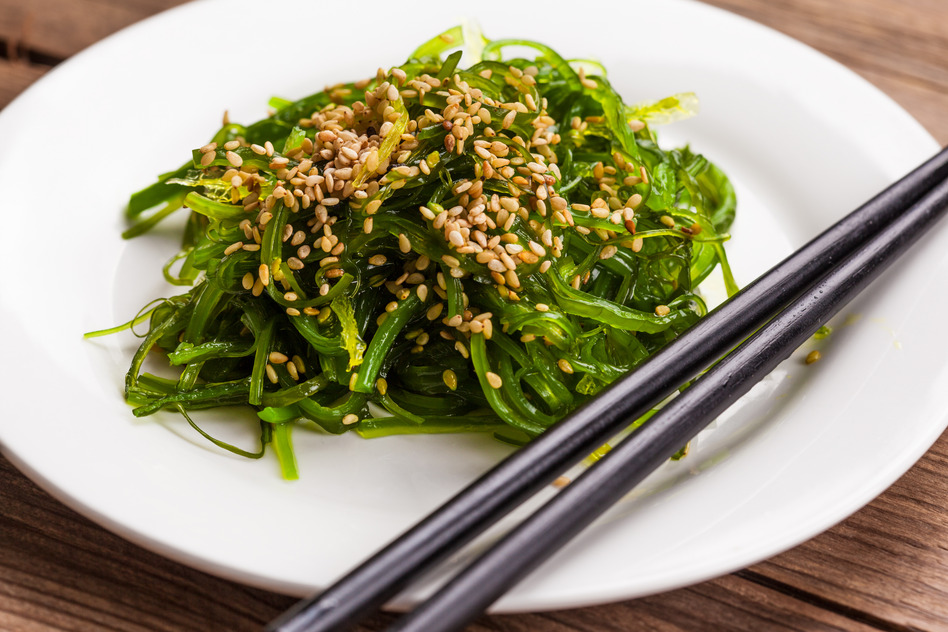
Seaweed is more than just an exotic food. It provides a bounty of health-enhancing nutrients that sustain good health and even help heal disease. It has been enjoyed as a staple in Japan for centuries, but it is considered more of a specialty food to many Americans. Few foods that we consume regularly in America have the potential healing properties of seaweed. If you’ve never eaten sea vegetables, you’ve at least seen them in the Oriental foods aisle at your local grocer, and perhaps they piqued your curiosity.
If you’re not a fan already, I hope the following information will cajole you into trying this surprisingly regenerative, versatile, and palatable food that also acts as medicine.
Nutrition
Seaweed is incredibly nutrient dense. Not only does it provide a host of minerals, it offers vitamins, iodine, amino acids and calcium. Hijiki, Arame and Wakame actually provide more calcium for a serving than drinking a glass of milk! They contain a safe source of fluorine, which is a halogen that boosts our body’s immune system. Seaweed delivers only four calories for a 10 gram serving and no fat! While seaweed is such a healthy food, you may want to be easy with salt or any high-sodium sauces to accompany seaweed because it already contains a bit of sodium. It also contains vitamin B12, but it is not available to our bodies the same way as it is from animal sources.
Medicinal uses
The wonder of low cancer rates in Japanese culture prompted dietary studies that lead to the discovery that seaweed has medicinal value. Some types of seaweed have been proven to remove radioactive waste and toxic metals from the human body. Two types of brown seaweed that are most noted for anti-carcinogenic properties are Kombu (aka kelp) and Wakame. They contain a polysaccharide called fucoidan, which has been found to destroy cancer cells in laboratory tests. When researchers introduced fucoidan to cancer cells in the laboratory, they found that the DNA of the cancer cells was broken down by the cell’s own digestive enzymes! Essentially, the cancer cells self-destructed. This is quite amazing because cancer cells are not programmed to die off, or undergo a process known to oncologists as apoptosis as do healthy cells. Scientists are still exploring ways to use seaweed extracts in lieu of toxic chemotherapy for cancer patients.
Preparation
So how do you prepare seaweed? Here, we purchase it as a dried shelf item or as capsules, but finding ways to partake of its goodness as a whole food is more satisfying. The most familiar form of seaweed as food is nori sheets used to wrap sushi, but this is only one of many ways to eat seaweed. Salads, stews and even candies can be made from seaweed. Many recipes call for soaking the dried product. If you want the benefit of the fluorine, its best to use those recipes since the fluorine content gets lost with cooking. Agar is good for making homemade jellies, vegetable molds and fruit desserts.
I found this easy-to-make, delectable recipe containing Wakame. It provides a light, clean meal without cooking in just four easy steps. This is just one of many wonderful ways to prepare this superfood.
You will need:
Dried Wakame seaweed: 3/4 ounce (20 grams)
Sesame seeds: 1 tbsp
Red chili pepper flakes: 1/2 tsp
Rice vinegar: 3 tbsp
Soy sauce: 1-2 tbsp
Sugar: 1/2-1 tbsp
Directions:
1. Soak dried seaweed in cold water for 20 minutes or until softened. After you drain it, cut off the hard spine. Chop and set aside.
2. Mix soy sauce, rice vinegar and sugar together well. Taste and adjust the soy sauce and sugar as you desire.
3. Pour the sauce mixture over the seaweed and mix together well.
4. Sprinkle sesame seeds and red pepper flakes over the salad, and serve.

